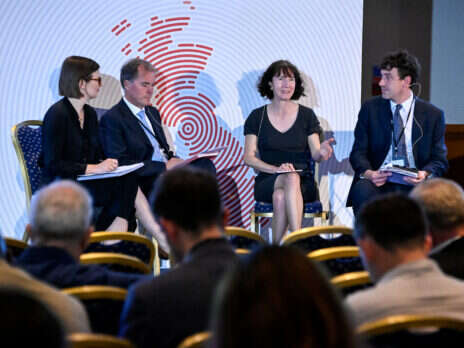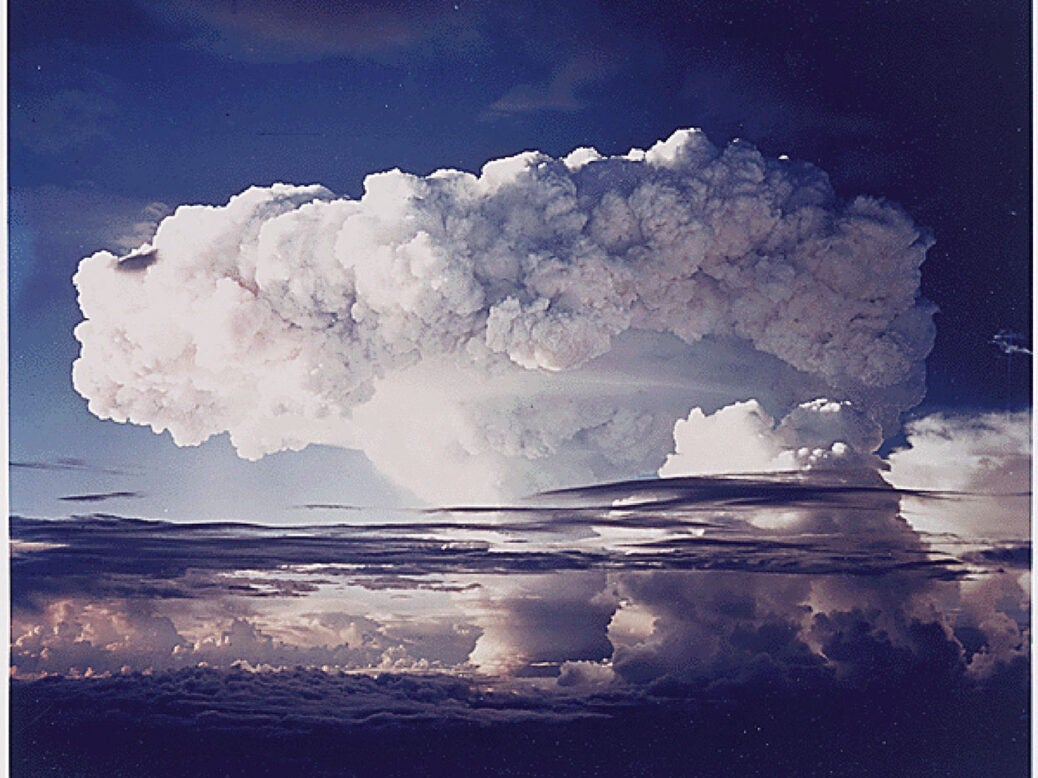Atoms and Ashes review: a history of nuclear accidents
Alamy
“Oh dear, now we are in a pickle.” According to his later reflections, these are the words that came to the mind of Arthur Wilson, a technician at the Windscale nuclear plant in Cumbria, when, on 10 October 1957, he saw that Pile No 1, the older of the site’s two reactors, was on fire. The thought, minus the characteristic British understatement, applies to each of the six nuclear accidents described in Serhii Plokhy’s captivating and extremely timely book.
But Atoms and Ashes also has a wider application. The whole of humanity is now “in a pickle”, facing as we are devastating and catastrophic climate change. For over 200 years we have been extracting coal, oil and gas from beneath the ground and burning it, thereby releasing into the atmosphere enormous quantities of carbon dioxide and warming the planet. Despite the increasingly urgent warnings from scientists, we continue to do it.
If we are to bequeath a liveable planet to subsequent generations, we have to stop using fossil fuels. This means finding alternative forms of energy. Wind and solar, of course, have got to keep expanding, but what happens when the wind doesn’t blow and the sun doesn’t shine? According to the UK government, the answer is nuclear energy, which at the moment provides about 15 per cent of the nation’s electricity. The government wants to increase that to 25 per cent by 2050 as part of its net zero target.
There are many problems with this. Nuclear energy is very expensive and reactors take a long time to build. As for whether it is safe, the government in its public statement “Nuclear energy: What you need to know” is unequivocal: “As confirmed by the UN’s International Atomic Energy Agency, nuclear power plants ‘are among the safest and most secure facilities in the world’, and nuclear power is one of the safest forms of energy generation.” “In the UK,” it goes on, “we have a well-respected regulatory system which reflects international best practice, and an industry which places an extremely high value on safety, achieving world-leading health and safety standards every time it is examined. Nuclear power has operated in the UK for decades without incident, and all UK nuclear operators are answerable to robust and independent regulators.”
Plokhy has another answer: “The debate on the safety of nuclear energy can be advanced by taking a fresh look at the history of nuclear accidents and trying to understand why they happened, how bad they were, what we can learn from them, and whether they can happen again.”
Sign up for The New Statesman’s newsletters
Tick the boxes of the newsletters you would like to receive.
The Crash
A weekly newsletter helping you fit together the pieces of the global economic slowdown.
Morning Call
Quick and essential guide to domestic and global politics from the New Statesman’s politics team.
World Review
The New Statesman’s global affairs newsletter, every Monday and Friday.
The New Statesman Daily
The best of the New Statesman, delivered to your inbox every weekday morning.
Green Times
The New Statesman’s weekly environment email on the politics, business and culture of the climate and nature crises – in your inbox every Thursday.
The Culture Edit
Our weekly culture newsletter – from books and art to pop culture and memes – sent every Friday.
Weekly Highlights
A weekly round-up of some of the best articles featured in the most recent issue of the New Statesman, sent each Saturday.
Ideas and Letters
A newsletter showcasing the finest writing from the ideas section and the NS archive, covering political ideas, philosophy, criticism and intellectual history – sent every Wednesday.
Events and Offers
Sign up to receive information regarding NS events, subscription offers & product updates.
Job titleAdministration / OfficeArts and CultureBoard MemberBusiness / Corporate ServicesClient / Customer ServicesCommunicationsConstruction, Works, EngineeringEducation, Curriculum and TeachingEnvironment, Conservation and NRMFacility / Grounds Management and MaintenanceFinance ManagementHealth – Medical and Nursing ManagementHR, Training and Organisational DevelopmentInformation and Communications TechnologyInformation Services, Statistics, Records, ArchivesInfrastructure Management – Transport, UtilitiesLegal Officers and PractitionersLibrarians and Library ManagementManagementMarketingOH&S, Risk ManagementOperations ManagementPlanning, Policy, StrategyPrinting, Design, Publishing, WebProjects, Programs and AdvisorsProperty, Assets and Fleet ManagementPublic Relations and MediaPurchasing and ProcurementQuality ManagementScience and Technical Research and DevelopmentSecurity and Law EnforcementService DeliverySport and RecreationTravel, Accommodation, TourismWellbeing, Community / Social Services
The six nuclear accidents that Plokhy discusses vary hugely, but there are some common themes, mostly to do with politics and military matters rather than with science and technology. From its very beginnings, nuclear energy has been inextricably mixed up with its military applications. The first person to envisage the release of the energy trapped inside atoms was HG Wells, who in his 1914 novel The World Set Free imagined an atom bomb that contained just a small amount of uranium. The first step in making that a reality was taken in 1932, when the physicists Ernest Walton and John Cockcroft split lithium atoms into alpha particles. When the chemists Otto Hahn and Fritz Strassmann split the (much heavier) uranium nucleus into barium and krypton at the end of 1938, it was quickly realised that such fission would release a great deal of energy and, in principle, start a chain reaction (the initial insight came from Lise Meitner and her nephew Otto Frisch).
[See also: World Review podcast: Can nuclear power ever be considered safe? With Serhii Plokhy]
Content from our partners



Within a few months, the search for the atom bomb was on. Not until several years after such a bomb was designed, built and used did scientists and politicians turn their attention to the use of nuclear energy for peaceful purposes. The accidents described by Plokhy divide equally between using nuclear power to make weapons and using it to generate electricity.
As a rule, the people to blame for these accidents are politicians and managers rather than physicists and engineers. The first one, however, was almost entirely the result of faulty science. Unlike the others, it concerns a bomb rather than a reactor. In March 1954 the US tested the world’s first hydrogen bomb (the earlier “Ivy Mike”, exploded in 1952, was a hydrogen device rather than a bomb – weighing in at 80 tons, it was not a useable weapon). The test was named “Castle Bravo” and the site chosen for it was the Bikini Atoll, part of the Marshall Islands in the central Pacific. “Shrimp”, as the bomb was called, was designed and built at Los Alamos National Laboratory in New Mexico, still, nine years after the war, home to some of the best nuclear physicists in the world.
Those eminent scientists, however, made a fatal error. The fusion fuel in Ivy Mike was liquid deuterium; in Shrimp it was replaced by lithium deuteride. The Los Alamos scientists had not realised that the lithium in lithium deuteride, when bombarded with very high-energy neutrons, would fission, releasing colossal amounts of energy and drastically increasing the yield of the bomb. Owing to this mistake, the bomb was many times more powerful than expected. Where they had estimated a yield of 6 megatons, the actual yield was 15 megatons, about a thousand times more powerful than the atom bomb that destroyed Hiroshima.
[See also: The risks of nuclear power in an increasingly destabilised world]
The people of the Rongelap and Rongerik islands, about 100 miles away from the test site, paid a heavy price for this error, as did the crew of the Daigo Fukuryu Maru (the Lucky Dragon 5), a Japanese fishing boat that was 70 miles away and 25 miles outside the danger zone patrolled by the US navy. Both islanders and fishermen were exposed to dangerous levels of radiation and radioactive fallout, the repercussions of which were still being felt many decades later. The United States had wanted to keep the Castle Bravo disaster a secret, but, largely because of the crew of the Lucky Dragon, news of it spread widely, inspiring anti-nuclear movements around the world.
This is a theme common to many of the accidents discussed by Plokhy: with each disaster, public faith in nuclear projects is diminished. This requires, however, that the public hear about the disaster. Every time an accident occurs, the government responsible tries to cover it up, or at least to play down the extent of the damage. In his second chapter, Plokhy discusses one of the few cases in which this was successful.
In terms of the radioactivity released, the Kyshtym disaster is second only to Chernobyl. And yet who has heard of it? It occurred in 1957 at the Maiak chemical complex, a plutonium-processing plant in the Ural Mountains near the Soviet town of Kyshtym. Safety standards at the plant were low and environmental concerns were a poor second best to the perceived need for the Soviet Union to keep up with the US’s nuclear arsenal. Radioactive waste was routinely dumped into local rivers and lakes. Nearby Lake Karachai, now filled in, still has the dubious honour of being titled “the most polluted spot on Earth”.
The plant was built in the late 1940s and in 1953 a storage facility for liquid nuclear waste was added, consisting of steel tanks mounted on a concrete base underground. On 29 September 1957, Tank No 14 exploded, releasing a cloud of radioactive material that eventually contaminated an area of nearly 8,000 square miles in the East Urals. Remarkably, even though they had to evacuate 10,000 people from the surrounding villages, the Soviet authorities managed to keep the disaster secret. Discussion of it was strictly forbidden and the contaminated area, previously known as the “East Ural Radioactive Trace” was rebranded as the East Ural Nature Reserve, which to this day remains closed to the public.
A month later, the UK suffered its own nuclear disaster at the Windscale plant, which, like Kyshtym, had been built to provide plutonium for atomic weapons. The fire that Arthur Wilson had seen was the result of a series of short cuts imposed upon the managers of Windscale by the military ambitions of the British government, who were in a hurry to show the Americans that the UK was capable of designing and building first a plutonium atomic bomb and then a hydrogen bomb. These short cuts made the over-heating of the uranium rods inside the reactors much more likely to happen, and much harder to deal with once it did. However, though the fire resulted in 32 deaths, 260 cases of cancer and the poisoning of milk produced in the farms around the site, the main story of Windscale is that of a lucky escape.
When work on the plant had started, John Cockcroft, who was by this time a Nobel Prize winner and Britain’s chief nuclear scientist, became persuaded that the tall stacks designed to carry hot air from the reactors into the sky needed to be fitted with filters to prevent radioactive particles from being released with the air. The managers were not convinced, but Cockcroft was too important to be ignored. The filters were fitted and became known as “Cockcroft’s folly”. It is estimated that 90 per cent of the radioactivity released by the fire was caught by those filters. Some folly.
The last three accidents covered by Plokhy’s book concern nuclear reactors that were built to provide electricity rather than fissile material for bombs: the incidents at Three Mile Island, Pennsylvania, Fukushima in Japan and, the biggest and most famous of them all, Chernobyl.
The accident at Chernobyl occurred on 26 April 1986 during a safety test in which, instead of shutting down, the No 4 reactor at the plant began an uncontrolled chain reaction, releasing huge amounts of energy. This led to a fire which for nine days belched out radioactive contamination, most of it falling onto nearby Belarus, though almost every country in western Europe was also affected. It is difficult to estimate how many deaths the accident caused. The Union of Concerned Scientists puts it at 50,000. The exclusion zone around the site extends to 1,660 square miles, and has become a wilderness, albeit one home to many species that had not been seen in the area for decades, including wolves, bears, bison and lynx.
[See also: Chernobyl’s political fallout]
The disaster had far-reaching consequences in other ways too. It led to a wave of protests, which Plokhy links to the independence of Ukraine, declared on 1 December 1991, and the break-up of the Soviet Union shortly thereafter. Before leaving the Soviet Union, Ukraine passed laws halting the construction of new reactors and declaring an intention to get rid of existing ones. These laws were quickly reversed, however, and today more than half of Ukraine’s electricity comes from nuclear power plants. Its nuclear station at Zaporizhzhia (which, in an act of jaw-dropping irresponsibility, the Russian army targeted with shells in March during its invasion) is the largest in Europe.
Why was faith in nuclear power restored so quickly and comprehensively? Plokhy suggests that “the nuclear industry persuaded the rest of the world that the lessons of Chernobyl had been learned and nothing of the kind could happen again”. In 2011 this was shown to be false when the nuclear plant at Fukushima was engulfed by the largest tsunami in Japanese history, leading to three meltdowns and explosions. It has been estimated that the accident caused 10,000 deaths, making Fukushima the second deadliest nuclear accident of all time. Germany reacted to Fukushima by voting to shut down every single nuclear reactor in the country by 2022.
How should we weigh the accidents so vividly described by Plokhy in the context of the urgent need to expand clean energy? The nuclear industry, knowing that demand for carbon-free energy sources will increase dramatically in the near future, is in a bullish mood. The World Nuclear Association has suggested that we need to raise the global share of nuclear-produced electricity from 10 per cent to 25 per cent, a target that, as we have seen, has been adopted by the UK government. This would mean building thousands of new reactors worldwide. Plokhy sounds a note of caution, quoting Gregory Jaczko, who resigned as the chairman of the US Nuclear Regulatory Commission in 2012 after it agreed to approve licences for two new reactors earlier that year. “First and foremost,” Jaczko says, “we must acknowledge that accidents will continue to happen.” Plokhy also cites the work of the scientists Thomas Rose and Trevor Sweeting, who have devised a mathematical model for predicting the likelihood of accidents, which suggests we are more likely than not to suffer one before 2036.
There are other big problems too, such as how to dispose of nuclear waste. To my mind, though, the most important drawback of nuclear energy is the time it takes to build a reactor. Hinkley Point C in Somerset received its licence in 2012 and was expected to be operational in 2021. This has now been pushed back to 2027. In transitioning away from fossil fuels we simply do not have this kind of time, as the latest IPCC report made very clear. We need to get more wind and solar plants operating as soon as possible and give top priority to solving the problem of how to store the energy they produce. In the meantime, if we are tempted to accept the bland reassurances of the UK government about the safety of nuclear power plants, Plokhy’s book provides a salutary warning of what could go wrong.
Atoms and Ashes: From Bikini Atoll to Fukushima
Serhii Plokhy
Allen Lane, 368pp, £25
Ray Monk is professor emeritus of philosophy at the University of Southampton and author of biographies including “Inside the Centre: The Life of Robert Oppenheimer” (Anchor)



Comments are closed.